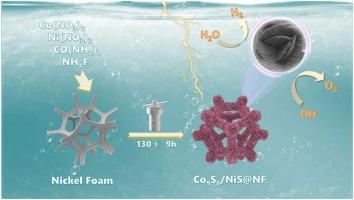缺陷工程Co9S8/NiS@NF纳米结构:联合异质结和硫空位用于优越的整体水电解
IF 6.3
2区 材料科学
Q2 CHEMISTRY, PHYSICAL
引用次数: 0
摘要
开发耐用、高性能的电催化剂以维持工业水平的电流密度是推进碱性电解的关键。在这项工作中,我们提出了一个分层Co9S8/NiS异质结直接通过水热和控制硫化过程在泡沫镍上生长。自支撑电极在10 mA cm-2和1 M KOH条件下提供260 mV (OER)和40 mV (HER)的低过电位。OER和HER的长期稳定性测试分别证实了在100 mA cm-2下超过30小时的95%和96%的电流保持。当在双电极配置中使用时,Co9S8/NiS@NF电极对在1.38 V下实现了10 mA cm-2的总体水分解,优于大多数报道的过渡金属硫化物系统。综合结构和光谱分析表明,Co9S8/NiS界面上的密切电子耦合以及丰富的硫空位协同优化了电荷分布并降低了动力学势垒。此外,自支撑集成电极的集成纳米花和纳米针形态提供了扩大的电化学活性表面积和有效的质量传输通道。这种双调制策略-结合异质结工程和缺陷化学-为设计满足实际制氢需求的非贵金属电催化剂提供了可扩展的途径。本文章由计算机程序翻译,如有差异,请以英文原文为准。

Defect-Engineered Co9S8/NiS@NF Nanoarchitectures: Uniting Heterojunctions and Sulfur Vacancies for Superior Overall Water Electrolysis
The development of durable, high-performance electrocatalysts capable of sustaining industrial-level current densities is critical for advancing alkaline water electrolysis. In this work, we present a hierarchical Co9S8/NiS heterojunction directly grown on nickel foam via hydrothermal and controlled sulfurization process. The self‐supported electrode delivers low overpotentials of 260 mV (OER) and 40 mV (HER) at 10 mA cm-2 in 1 M KOH. Long‐term stability tests of OER and HER respectively confirm 95% and 96% current retention at 100 mA cm-2 over 30 h. When employed in a two-electrode configuration, the Co9S8/NiS@NF electrode pair achieves 10 mA cm-2 overall water splitting at just 1.38 V, outperforming most reported transition‐metal sulfide systems. Comprehensive structural and spectroscopic analyses reveals that intimate electronic coupling at the Co9S8/NiS interface, together with abundant sulfur vacancies, synergistically optimizes charge distribution and lowers kinetic barriers. Moreover, the integrated nano-flower and nano-needle morphology of self-supporting integrated electrode provides an expanded electrochemically active surface area and efficient mass-transport channels. This dual‐modulation strategy—combining heterojunction engineering with defect chemistry—provides a scalable path for designing non‐precious‐metal electrocatalysts that meet the demands of practical hydrogen production.
求助全文
通过发布文献求助,成功后即可免费获取论文全文。
去求助
来源期刊

Journal of Alloys and Compounds
工程技术-材料科学:综合
CiteScore
11.10
自引率
14.50%
发文量
5146
审稿时长
67 days
期刊介绍:
The Journal of Alloys and Compounds is intended to serve as an international medium for the publication of work on solid materials comprising compounds as well as alloys. Its great strength lies in the diversity of discipline which it encompasses, drawing together results from materials science, solid-state chemistry and physics.
 求助内容:
求助内容: 应助结果提醒方式:
应助结果提醒方式:


